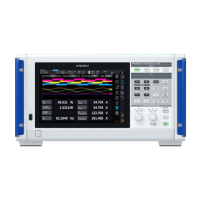78
Motor Measurement (Motor Analysis-Equipped Model)
3.6 Motor Measurement
(Motor Analysis-Equipped Model)
The motor analysis-equipped model can perform motor analysis when used with an external torque
sensor and tachometer. In addition, the motor input parts used in motor analysis can also be used
as independent inputs, such as analog DC (up to four channels) or pulse (up to eight channels), or
waveform measurement triggers.
See “Conguring the trigger settings” (p. 100).
Motor measurement wiring
The motor analysis-equipped model can perform motor analysis when used with external torque
sensors and tachometers. The motor analysis function can be used to measure torque, RPM,
motor power, and slip by inputting the signals from torque sensors and tachometers, such as rotary
encoders (incremental type).
In addition, the input parts can be used as four analog channels and four pulse input channels.
Connecting torque meters and tachometers
The motor analysis-equipped model have eight input connectors (insulated BNC connectors) on the
rear panel of the instrument. Because each connector (labeled Ch. A through Ch. H) is insulated
from the instrument itself and from each other, various types of sensors with diering ground
potentials are connectable.
Ch. A, Ch. C, Ch. E, Ch. G Analog DC, frequency, and pulse inputs
Ch. B, Ch. D, Ch. F, Ch. H Frequency and pulse inputs
In addition to using the channels in combination for motor analysis, they can also be used as
independent analog signal/pulse signal input channels.
WARNING
When connecting input terminals to Ch. A through Ch. H
Always turn o the instrument and other equipment being connected
before making any connections, and make sure the connections are
secure.
Do not input a signal that exceeds the rating of any connector.
Failure to do so could cause connectors to loosen and come into contact with other
conductive parts, resulting in bodily injury and damage to the equipment.
NOTICE
When disconnecting cables, disengage the lock and then pull out the BNC
connector while gripping it at the connection (do not pull on the cable).
Failure to do so could damage the BNC connector.
BNC connector’ slots
Lugs on the instrument’s
input terminal
Lock

